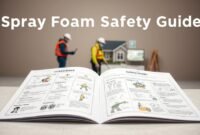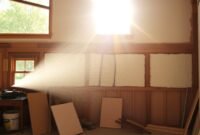Are you concerned about the fire safety of your fiberglass insulation? Don’t worry, it’s not flammable by nature. But, it has some special properties you should know about. It has a good R-value, ranging from R-2.9 to R-3.8 per inch, which means it can resist heat well.
Yet, it can melt at about 1,000 degrees Fahrenheit. This could release oxygen, helping fires spread. The important thing is to install and keep your fiberglass insulation right to avoid fire risks.
Key Takeaways
- Fiberglass insulation is naturally noncombustible, made from sand and recycled glass.
- It has a high melting point of around 1,000 degrees Fahrenheit, but can release oxygen at those temperatures.
- Proper installation and maintenance are key to avoiding fire hazards from fiberglass insulation.
- High-quality fiberglass products often have special coatings to boost fire resistance.
- Fiberglass suppliers offer a variety of fire-resistant insulation options.

What Is Fiberglass Insulation?
Fiberglass insulation is a key product for making buildings more energy-efficient. It’s made from silica sand, limestone, and other materials. These are heated to 2,500 Fahrenheit to create fibers. This material helps keep buildings warm in winter and cool in summer.
Key Components and Properties
Fiberglass insulation has important qualities. It keeps temperatures steady, fights moisture, and blocks sound. These traits make it a top pick for those who want energy savings and comfort. It also comes in different R-values to fit various needs.
How It Is Manufactured
- The raw materials, including silica sand, limestone, and soda ash, are heated to extremely high temperatures, typically around 2,500 Fahrenheit.
- This intense heat melts the materials, allowing them to be spun into fine fibers and filaments.
- Some manufacturers may apply special coatings and lubricants to the fiberglass to enhance product quality and performance.
- The finished product is then cut, shaped, and packaged for distribution and installation in homes, commercial buildings, and industrial applications.
This process makes a material that cuts down on heat loss and gain. Fiberglass insulation is a top choice for boosting energy efficiency. Knowing how it’s made helps us see its value and uses.
Is Fiberglass Insulation Flammable?
Fiberglass insulation is not very flammable. It can melt or break down at high temperatures. Even though it doesn’t catch fire easily, it can spread fire if it melts and releases oxygen. To make it safer, many manufacturers add special fire retardants to it.
Fire-Resistant Features
Fiberglass insulation is not easily set on fire. It’s made from sand, recycled glass, and minerals. This makes it noncombustible, meaning it doesn’t catch fire or add much to a fire’s size.
Read also: How To Easily Insulate Your Walls Without Removing The Drywall
How Fiberglass Reacts to Heat
Fiberglass insulation melts at over 540 degrees Celsius (1,000 degrees Fahrenheit). This is much hotter than most house fires. But, the melted fiberglass can release oxygen, helping fire spread. It’s important to install it right, avoiding heat sources like chimneys.
Fire Retardant Treatments
Many fiberglass insulation products have fire-retardant coatings or additives. These help the insulation handle high temperatures better. They also meet strict fire safety standards, making fiberglass a safer choice than some other materials.

Fire Safety Standards
Fire safety is key when choosing insulation materials. These standards check how well materials handle fire and smoke. Knowing these standards helps pick the right insulation for safety.
Industry Fire Ratings Explained
Insulation materials are tested for fire safety with industry ratings. The Flame Spread Index (FSI) shows how fast a material spreads flames. Fiberglass has an FSI of 0, meaning it’s very safe. Spray foam can have ratings up to 75+.
The Smoke Developed Index (SDI) also matters. It shows how much smoke a material makes in a fire. Fiberglass and mineral wool score low on this scale, making them great for fire-prone areas.
Building Code Requirements
Building codes set fire safety rules for insulation. These rules might require certain ratings or safety features like sprinklers. Following these codes is vital for fire rating, local building codes, and safety measures.
When picking insulation, check the fire rating, local building codes, and safety measures. This ensures the insulation meets fire safety standards. This way, homes and buildings stay safe and well-insulated.
Read also: What Is the Difference Between Faced And Unfaced Insulation
Fiberglass vs. Other Insulation Materials
Fiberglass insulation is a strong contender in fire safety. It stands up well against other popular types like mineral wool, cellulose, and foam. It offers a good mix of fire resistance, affordability, and insulation quality.
Comparing Fire Resistance
Mineral wool is the top choice for fire resistance, handling temperatures over 1,800°F. Fiberglass is also noncombustible and doesn’t need fire-retardant treatments. But, cellulose insulation, made from recycled paper, is very flammable, even with fire retardants.
Foam insulations, whether spray or board, are also flammable. They can release toxic smoke when exposed to high heat.
Which Insulation Offers More Safety?
- Fiberglass and mineral wool are safer, not classified as carcinogens by IARC, NTP, and California OEHHA.
- Cellulose insulation has health concerns due to limited toxicological testing. Spray foam insulation contains chemicals that can harm lungs and cause asthma.
- Fiberglass, mineral wool, and spray foam do not promote mold growth, unlike cellulose insulation.
- Fiberglass insulation is also non-corrosive. It doesn’t harm pipes and wires, unlike cellulose insulation.
Fiberglass insulation may not be the most fire-resistant. But, it’s a reliable choice for safety, cost, and insulation quality. It’s a favorite among homeowners and builders.
Fire Safety During Installation
Proper installation is key for fire safety with insulation like fiberglass. When putting insulation in walls, attics, or other spots, follow best practices. This helps avoid fire hazards.
Proper Installation Techniques
To install insulation safely, follow the manufacturer’s guide and local building codes. Keep insulation away from heat sources like recessed lighting or chimneys. Also, make sure there’s good air flow to avoid heat buildup.
Common Fire Hazards to Avoid
- Avoid smoking, open flames, or “hot work” (e.g., welding, cutting) in the installation area, as these can ignite insulation materials.
- Use appropriate personal protective equipment (PPE), such as gloves and eye protection, to handle insulation safely and prevent skin irritation.
- For spray foam insulation, only allow installation by trained professionals due to the combustible nature of its components during application.
| Fire Safety Codes and Standards | Description |
|---|---|
| ASTM E84 | Measures the Flame Spread Rating and Smoke Developed Rating of insulation materials. |
| ASTM E136 | Classifies materials as “non-combustible” and sets criteria for flammability. |
| ASTM E119 and UL 1790 | Assess the fire resistance of insulation in different scenarios, such as building construction or petrochemical facilities. |
By using the right installation methods and watching out for fire hazards, you can ensure insulation, including fiberglass, is installed safely. This protects your home or building from fire risks.
Maintaining Insulation for Safety
Keeping my home safe and efficient is very important. Regular checks help make sure my insulation works well. This includes keeping it energy-efficient and fire-resistant. By being careful and fixing problems fast, my home stays safe and cozy.
Routine Inspection Tips
I check my insulation every year, or more if I see any problems. First, I look for moisture, which can harm the insulation and cause mold. I also check for gaps or settling in loose-fill insulation. These issues can reduce its effectiveness.
Read also: How Long Does Attic Insulation Last?
Signs of Deterioration
I watch for any color changes or texture issues in the insulation too. These might mean it’s been damaged by heat. If I see these signs, I fix the problem right away. This keeps my home safe and energy-efficient.


